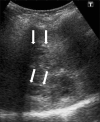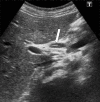Radiological Imaging Features of Fasciola hepatica Infection - A Pictorial Review
- PMID: 22347685
- PMCID: PMC3279695
- DOI: 10.4103/2156-7514.92372
Radiological Imaging Features of Fasciola hepatica Infection - A Pictorial Review
Abstract
Fascioliasis refers to a zoonosis caused by Fasciola hepatica, a trematode infecting herbivores, but also occurs in humans who ingest the metacercaria found in fresh water plants. Infection in humans is common in developing countries and is also not uncommon in Europe. Diagnosis of this infection is difficult, as the history and symptoms are nonspecific and stool analysis for eggs is negative until the disease is in an advanced state by when the parasite has reached the biliary system. The clinical course consists of two phases; first a hepatic parenchymal phase in which immature larvae invade the liver parenchyma, followed by a ductal phase characterized by the excretion of larvae into the bile ducts. Parenchymal Phase: Ultrasonography (US) findings are nonspecific in this early phase. Computerized tomography (CT) may demonstrate subcapsular low attenuation regions in the liver. Magnetic Resonance imaging (MRI) can also be utilized to establish liver parenchymal involvement, and is better than CT in characterizing hemorrhagic lesions, as well as identifying more lesions relative to CT. Ductal Phase: US examination is most useful at this stage, with its ability to demonstrate the live movement of the worms within the dilated ducts. A CT demonstrates dilated central biliary ducts with periportal tracking, whereas, mild ductal dilatation is poorly appreciated under MRI. Therefore, familiarity with the multimodality imaging features of fascioliasis, in combination with an available confirmatory enzyme-linked immunoassay, would be most helpful for early diagnosis.
Keywords: Fasciola hepatica; Fascioliasis; amoebic abscess; hydatid disease; pyogenic abscess; radiological imaging features.
Conflict of interest statement
Figures



















Similar articles
-
Experimental hepatobiliary fascioliasis in rabbits: a radiology-pathology correlation.Invest Radiol. 1999 Feb;34(2):99-108. doi: 10.1097/00004424-199902000-00002. Invest Radiol. 1999. PMID: 9951789
-
Diagnostic imaging in sheep hepatic fascioliasis: ultrasound, computer tomography and magnetic resonance findings.Parasitol Res. 2003 Aug;90(5):359-64. doi: 10.1007/s00436-003-0866-x. Epub 2003 Apr 17. Parasitol Res. 2003. PMID: 12700980
-
Clinical presentation and management of Fasciola hepatica infection: single-center experience.World J Gastroenterol. 2011 Nov 28;17(44):4899-904. doi: 10.3748/wjg.v17.i44.4899. World J Gastroenterol. 2011. PMID: 22171131 Free PMC article.
-
Imaging findings of human hepatic fascioliasis: a case report and review of the literature.J Med Case Rep. 2021 Jun 24;15(1):324. doi: 10.1186/s13256-021-02945-9. J Med Case Rep. 2021. PMID: 34162437 Free PMC article. Review.
-
Biliary parasitic diseases including clonorchiasis, opisthorchiasis and fascioliasis.Abdom Imaging. 2008 Mar-Apr;33(2):157-65. doi: 10.1007/s00261-007-9326-x. Abdom Imaging. 2008. PMID: 17934771 Review.
Cited by
-
Parasitic diseases as a cause of acute abdominal pain: imaging findings.Insights Imaging. 2020 Jul 20;11(1):86. doi: 10.1186/s13244-020-00892-5. Insights Imaging. 2020. PMID: 32691171 Free PMC article. Review.
-
Hepatic parasitic abscess resistant to traditional anthelmintics: difficulty of diagnosis and treatment of fascioliasis in the USA.BMJ Case Rep. 2021 Jul 20;14(7):e242613. doi: 10.1136/bcr-2021-242613. BMJ Case Rep. 2021. PMID: 34285020 Free PMC article.
-
Abdominal CT scan findings of a child with hepatic fascioliasis: A case report on rarely reported emerging disease.Radiol Case Rep. 2025 Feb 1;20(4):2180-2183. doi: 10.1016/j.radcr.2025.01.030. eCollection 2025 Apr. Radiol Case Rep. 2025. PMID: 39975650 Free PMC article.
-
Eosinophilic Hepatitis.J Allergy Clin Immunol Pract. 2024 Dec;12(12):3457-3459.e25. doi: 10.1016/j.jaip.2024.09.031. J Allergy Clin Immunol Pract. 2024. PMID: 39645360 No abstract available.
-
First case report of retroperitoneal metastasis of fascioliasis after surgery.Medicine (Baltimore). 2017 Dec;96(50):e9258. doi: 10.1097/MD.0000000000009258. Medicine (Baltimore). 2017. PMID: 29390366 Free PMC article.
References
-
- Marcos LA, Terashima A, Gotuzzo E. Update on hepatobiliary flukes: Fascioliasis, opisthorchiasis and clonorchiasis. Curr Opin Infect Dis. 2008;21:523–30. - PubMed
-
- Gonzalo-Orden M, Millán L, Alvarez M, Sánchez-Campos S, Jiménez R, González-Gallego J, et al. Diagnostic imaging in sheep hepatic fascioliasis: Ultrasound, computer tomography and magnetic resonance findings. Parasitol Res. 2003;90:359–64. - PubMed
-
- Mas-Coma S, Bargues MD, Valero MA. Fascioliasis and other plant-borne trematode zoonoses. Int J Parasitol. 2005;35:1255–78. - PubMed
-
- Lim JH, Mairiang E, Ahn GH. Biliary parasitic diseases including clonorchiasis, opisthorchiasis and fascioliasis. Abdom Imaging. 2008;33:157–65. - PubMed
-
- Han JK, Jang HJ, Choi BI, Kim SH, Kim TK, Won HJ, et al. Experimental hepatobiliary fascioliasis in rabbits: A radiology-pathology correlation. Investig Radiol. 1999;34:99–108. - PubMed
LinkOut - more resources
Full Text Sources

